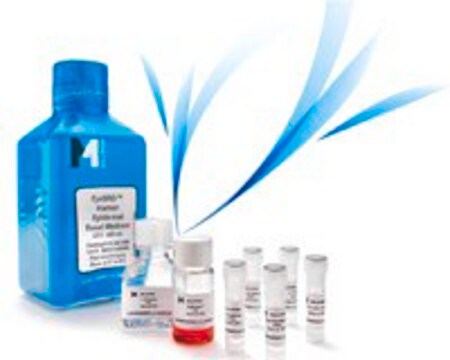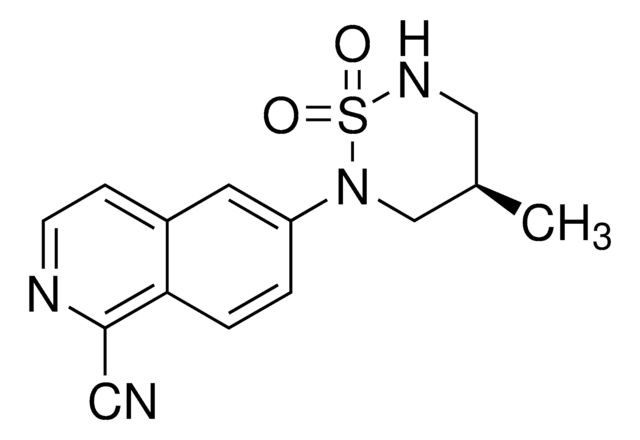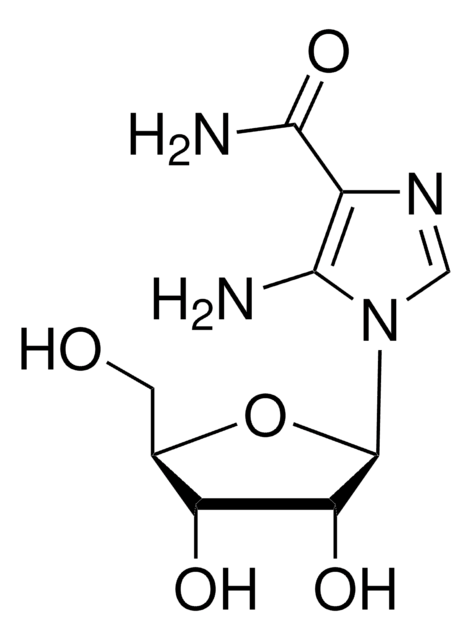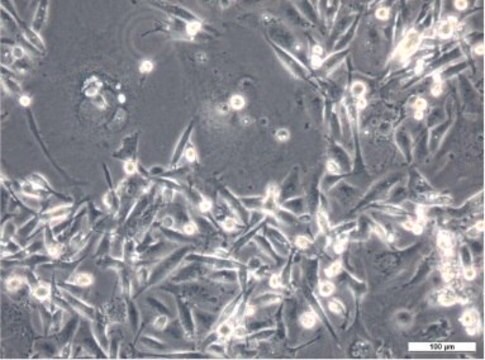추천 제품
제품명
Blood-Brain Barrier hCMEC/D3 Cell Line, The hCMEC/D3 BBB cell line has been extensively characterized for brain endothelial phenotype and is a model of human blood-brain barrier (BBB) function.
생물학적 소스
human
Quality Level
기술
cell culture | mammalian: suitable
drug transporter assay: suitable
배송 상태
liquid nitrogen
일반 설명
The blood–brain barrier (BBB) is a highly selective permeability barrier that separates the circulating blood from the brain extracellular fluid in the central nervous system. The blood–brain barrier is formed by capillary endothelial cells, which are connected by tight junctions with an extremely high electrical resistivity. The blood–brain barrier allows the passage of water, some gases, and lipid soluble molecules by passive diffusion, as well as the selective transport of molecules such as glucose and amino acids that are crucial to neural function. On the other hand, the blood–brain barrier may prevent the entry of lipophilic, potential neurotoxins by way of an active transport mechanism mediated by P-glycoprotein. Astrocytes are necessary to create the blood–brain barrier. The blood–brain barrier (BBB) prevents entry into the brain of most drugs from the blood. The presence of the BBB makes difficult the development of new treatments of brain diseases, or new radiopharmaceuticals for neuroimaging of brain.
The hCMEC/D3 cell line was derived from human temporal lobe microvessels isolated from tissue excised during surgery for control of epilepsy. The primary isolate was enriched in cerebral endothelial cells (CECs). In the first passage, cells were sequentially immortalized by lentiviral vector transduction with the catalytic subunit of human telomerase (hTERT) and SV40 large T antigen, following which CEC were selectively isolated by limited dilution cloning, and clones were extensively characterized for brain endothelial phenotype. This brain microvascular endothelial cell line represents one such model of the human BBB that can be easily grown and is amenable to cellular and molecular studies on pathological and drug transport mechanisms with relevance to the central nervous system (CNS).
Reference:
Couraud PO, et al. (2008) The human brain endothelial cell line hCMEC/D3 as a human blood‐brain barrier model for drug transport studies. Fluids Barriers CNS. 2013 Mar 26;10(1):16.
Reference:
Couraud PO, et al. (2008) The human brain endothelial cell line hCMEC/D3 as a human blood‐brain barrier model for drug transport studies. Fluids Barriers CNS. 2013 Mar 26;10(1):16.
세포주 설명
Endothelial Cells
애플리케이션
Research Category
Neuroscience
Neuroscience
Research Sub Category
Neurodegenerative Diseases
Neurodegenerative Diseases
The hCMEC/D3 BBB cell line has been extensively characterized for brain endothelial phenotype and is a model of human blood-brain barrier (BBB) function.
This product is intended for sale and sold solely for internal non-commercial research use per the terms of the “Restricted Use Agreement” as detailed in the product documentation. For information regarding any other uses, please contact licensing@emdmillipore.com.
품질
• Each vial contains ≥ 1X10^6 viable cells.
• Cells are tested by PCR and are negative for Hepatitis A, B, C, HPV, Herpes and HIV-1 & 2 viruses.
• Cells are negative for mycoplasma contamination.
• Cells are tested by PCR and are negative for Hepatitis A, B, C, HPV, Herpes and HIV-1 & 2 viruses.
• Cells are negative for mycoplasma contamination.
저장 및 안정성
Blood-Brain Barrier hCMEC/D3 cells should be stored in liquid nitrogen. The cells can be passage for at least 10 passages without significantly affecting the cell marker expression and functionality.
면책조항
RESEARCH USE ONLY. This product is regulated in France when intended to be used for scientific purposes, including for import and export activities (Article L 1211-1 paragraph 2 of the Public Health Code). The purchaser (i.e. enduser) is required to obtain an import authorization from the France Ministry of Research referred in the Article L1245-5-1 II. of Public Health Code. By ordering this product, you are confirming that you have obtained the proper import authorization.
Unless otherwise stated in our catalog or other company documentation accompanying the product(s), our products are intended for research use only and are not to be used for any other purpose, which includes but is not limited to, unauthorized commercial uses, in vitro diagnostic uses, ex vivo or in vivo therapeutic uses or any type of consumption or application to humans or animals.
This product contains genetically modified organisms (GMO). Within the EU GMOs are regulated by Directives 2001/18/EC and 2009/41/EC of the European Parliament and of the Council and their national implementation in the member States respectively. This legislation obliges {HCompany} to request certain information about you and the establishment where the GMOs are being handled. Click here for Enduser Declaration (EUD) Form.
This product contains genetically modified organisms (GMO). Within the EU GMOs are regulated by Directives 2001/18/EC and 2009/41/EC of the European Parliament and of the Council and their national implementation in the member States respectively. This legislation obliges {HCompany} to request certain information about you and the establishment where the GMOs are being handled. Click here for Enduser Declaration (EUD) Form.
Storage Class Code
12 - Non Combustible Liquids
WGK
WGK 1
Flash Point (°F)
Not applicable
Flash Point (°C)
Not applicable
시험 성적서(COA)
제품의 로트/배치 번호를 입력하여 시험 성적서(COA)을 검색하십시오. 로트 및 배치 번호는 제품 라벨에 있는 ‘로트’ 또는 ‘배치’라는 용어 뒤에서 찾을 수 있습니다.
Nadia Peyravian et al.
Molecular pharmaceutics, 19(7), 2254-2267 (2022-05-05)
The United States is in the midst of an opioid epidemic that is linked to a number of serious health issues, including an increase in cerebrovascular events, namely, stroke. Chronic prescription opioid use exacerbates the risk and severity of ischemic
Sophie Gong et al.
SLAS discovery : advancing life sciences R & D, 23(8), 832-841 (2018-03-06)
Antibody-triggered endocytosis (ATE) is a biological mechanism on which many therapeutic strategies are grounded, such as delivery of antibody-drug conjugates (ADCs). Current methods monitoring ATE include confocal Z-stack analysis, acid wash, antibody quenching, and pH-sensitive dye labeling. However, those generate
Jim Zoladek et al.
Frontiers in microbiology, 12, 746589-746589 (2021-10-08)
Zika virus (ZIKV) infection has been associated with a series of neurological pathologies. In patients with ZIKV-induced neurological disorders, the virus is detectable in the central nervous system. Thus, ZIKV is capable of neuroinvasion, presumably through infection of the endothelial
Kathryn M Styles et al.
Antibiotics (Basel, Switzerland), 9(4) (2020-04-26)
The multi-drug resistance of the opportunistic pathogen Acinetobacter baumannii is of growing concern, with many clinical isolates proving to be resistant to last resort as well as front line antibiotic treatments. The use of bacteriophages is an attractive alternative to
Zsolt Szűcs et al.
Scientific reports, 12(1), 20921-20921 (2022-12-04)
Gram-negative bacteria possess intrinsic resistance to glycopeptide antibiotics so these important antibacterial medications are only suitable for the treatment of Gram-positive bacterial infections. At the same time, polymyxins are peptide antibiotics, structurally related to glycopeptides, with remarkable activity against Gram-negative
자사의 과학자팀은 생명 과학, 재료 과학, 화학 합성, 크로마토그래피, 분석 및 기타 많은 영역을 포함한 모든 과학 분야에 경험이 있습니다..
고객지원팀으로 연락바랍니다.







